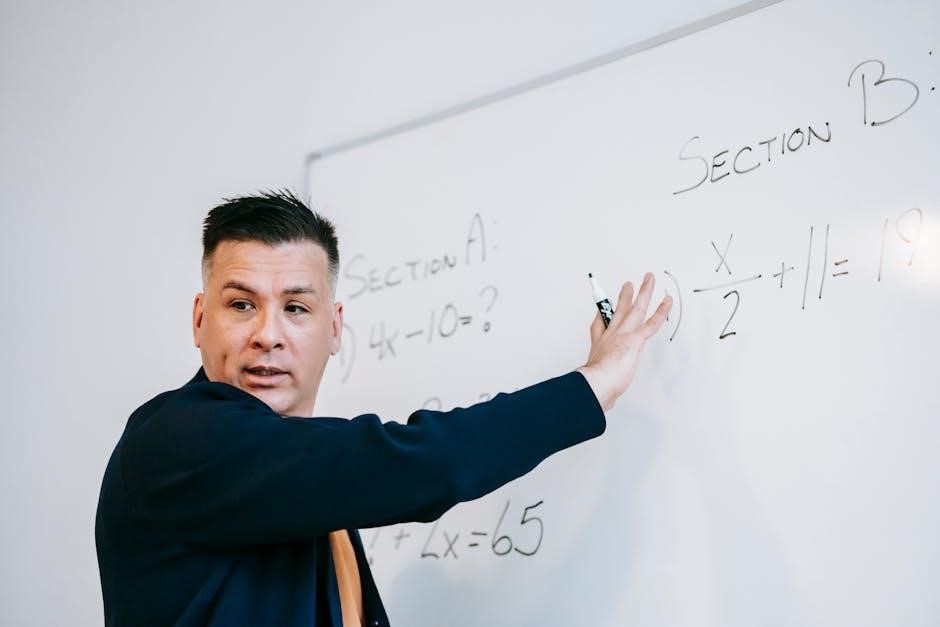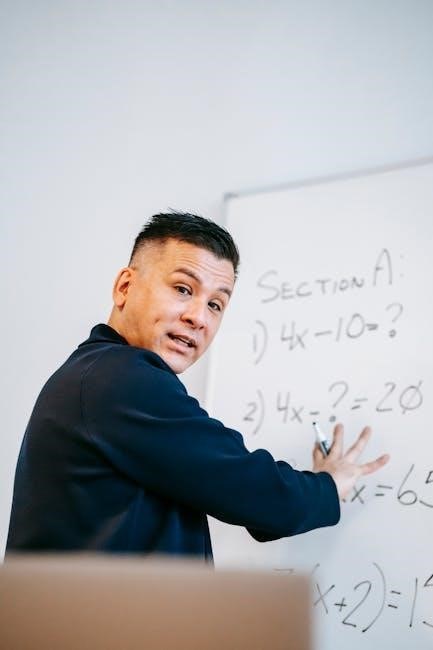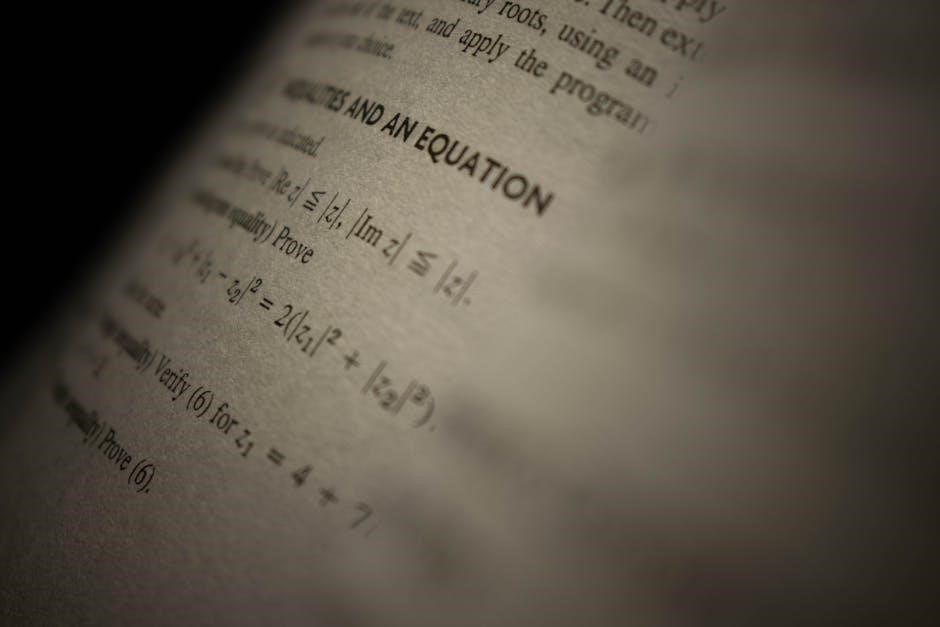direct instruction math
Direct Instruction Math is a structured, teacher-directed approach emphasizing explicit teaching and mastery of skills. It focuses on clear explanations, guided practice, and immediate feedback to ensure understanding and proficiency in mathematical concepts.
1.1 Definition and Overview
Direct Instruction Math is a systematic, teacher-led approach that emphasizes explicit teaching and mastery of mathematical skills. It involves clear explanations, step-by-step demonstrations, and structured lessons to ensure students grasp concepts thoroughly. This method focuses on active participation, immediate feedback, and incremental learning to build a strong foundation in math.
1.2 Historical Background
Direct Instruction Math emerged in the 1960s, influenced by behaviorist psychology and the work of educators like Siegfried Engelmann. Funded by the U.S. Office of Education, Engelmann and his collaborators developed structured math programs emphasizing explicit teaching. These programs, such as “DISTAR,” focused on clear lessons, immediate feedback, and measurable outcomes, initially met with enthusiasm but later faced criticism for rigidity. Over time, the approach evolved to address diverse learning needs while maintaining its core principles.
1.3 Core Principles
Direct Instruction Math is built on explicit teaching, breaking skills into small steps, and ensuring mastery before progressing. It emphasizes teacher-led instruction, scripted lessons for consistency, and frequent assessments. The approach prioritizes accuracy, with immediate error correction to prevent misconceptions. Lessons are fast-paced and engaging, designed to maximize student involvement and minimize distractions, ensuring all learners meet high academic standards effectively.

Key Components of Direct Instruction Math
Direct Instruction Math emphasizes explicit teaching, structured lessons, and mastery of skills. It relies on teacher-led instruction, clear explanations, and systematic practice to ensure student understanding and proficiency.
2.1 Explicit Teaching Methods
Explicit teaching methods in Direct Instruction Math involve clear, step-by-step demonstrations and explanations. Teachers use systematic instruction, breaking down complex concepts into manageable parts. This approach ensures students understand each skill before progressing, reducing confusion and reinforcing foundational knowledge. Immediate feedback and guided practice further enhance learning, making explicit teaching a cornerstone of this method’s effectiveness.
2.2 Scripted Lessons
Scripted lessons in Direct Instruction Math provide teachers with detailed, pre-prepared instructional material. These scripts outline every step, ensuring consistency and fidelity to the curriculum. They guide teachers through introductions, modeling, guided practice, and independent practice, aligning with the program’s structured approach. This ensures all students receive high-quality, uniform instruction, maintaining instructional quality and curriculum fidelity across classrooms and teachers.
2.3 Mastery Learning
Mastery Learning ensures students fully understand and master each math concept before progressing. This approach uses assessments to identify gaps, allowing targeted reteaching. By focusing on complete understanding, it minimizes future learning difficulties, ensuring a strong foundation for advanced topics. This method aligns with Direct Instruction’s emphasis on clarity and precision, fostering long-term retention and confidence in math skills.

Benefits of Direct Instruction Math
Direct Instruction Math improves academic outcomes, enhances teacher effectiveness, and supports diverse learners through structured, explicit teaching, ensuring all students master essential math skills effectively and efficiently.
3.1 Improved Academic Outcomes
Direct Instruction Math leads to improved academic outcomes by ensuring students master foundational math concepts through explicit teaching and guided practice. This structured approach reduces learning gaps, as all students receive consistent instruction and immediate feedback, fostering a deeper understanding and long-term retention of mathematical skills. The method is particularly effective in improving test scores and preparing students for advanced math topics.
3.2 Enhanced Teacher Effectiveness
Direct Instruction Math enhances teacher effectiveness by providing clear, structured lesson plans and scripts, ensuring consistency in delivery. Teachers can focus on pacing, engagement, and addressing errors in real-time, leading to more efficient and impactful instruction. This method equips educators with tools to manage classrooms effectively, fostering a supportive learning environment and maximizing student achievement through systematic teaching practices.
3.3 Support for Diverse Learners
Direct Instruction Math offers tailored support for diverse learners through scaffolded instruction, ensuring all students grasp concepts before moving forward. Scripted lessons and explicit teaching methods accommodate varying learning paces, while immediate feedback helps identify and address individual needs. This approach ensures inclusivity and equity, enabling students with different abilities to achieve mastery and build confidence in their mathematical skills effectively.
Lesson Structure in Direct Instruction Math
Direct Instruction Math lessons follow a structured sequence: introduction, modeling, guided practice, independent practice, and assessment, ensuring clear progression and mastery of skills.
The lesson begins with an introduction to the new concept, followed by a review of previously taught material. This ensures continuity and reinforces foundational skills, making it easier for students to grasp new information. The teacher provides a clear overview of the lesson’s objectives and connects it to prior learning, creating a cohesive educational experience.
4.2 Modeling and Demonstration
Modeling and demonstration involve the teacher explicitly showing students how to solve problems. The teacher provides clear, step-by-step explanations and examples, ensuring students understand each concept. Visual aids and real-life examples are often used to make abstract ideas tangible. This method allows students to observe and imitate the problem-solving process, fostering comprehension and reducing confusion. Immediate checks for understanding ensure engagement and clarity.
4.3 Guided Practice
Guided practice involves teachers leading students through structured exercises, providing support and feedback as they apply newly learned skills. This step ensures comprehension by actively engaging students in problem-solving under supervision. Teachers often use think-aloud methods to model their reasoning, while students work in pairs or small groups. Immediate correction of errors and reinforcement of correct methods help solidify understanding before transitioning to independent practice.
4.4 Independent Practice
Independent practice allows students to apply skills without teacher assistance, reinforcing their mastery of concepts. Assignments are tailored to individual readiness, ensuring tasks are challenging yet achievable. This phase solidifies learning by enabling students to problem-solve autonomously, fostering confidence and self-reliance in mathematical thinking. The goal is for students to demonstrate proficiency and retain skills long-term, preparing them for more complex challenges ahead.
4.5 Assessment and Feedback
Assessment and feedback are integral to Direct Instruction Math, ensuring students meet mastery criteria. Teachers use quizzes and exercises to evaluate understanding, providing immediate, specific feedback to correct errors. This step reinforces learning, clarifies misconceptions, and identifies areas needing review. Timely feedback enables students to adjust their approach, fostering a deeper understanding and preparing them for subsequent lessons effectively.

Role of the Teacher
The teacher plays a central role in delivering structured, clear lessons, maintaining pace, engaging students, and correcting errors to ensure mastery and effective learning outcomes.
5.1 Scripted Lessons and Fidelity
Scripted lessons in Direct Instruction Math provide teachers with detailed, step-by-step guides to ensure consistency and fidelity in delivering the curriculum. This approach minimizes teacher variability, aligning instruction with curriculum goals and promoting accurate implementation. By adhering to scripted lessons, teachers can effectively manage the pacing and content, ensuring students receive a coherent and structured learning experience. Fidelity is crucial for achieving the intended outcomes of the Direct Instruction model.
- Ensures consistency across classrooms.
- Supports alignment with curriculum standards.
- Enhances the effectiveness of instruction.
5.2 Maintaining Pace and Engagement
Teachers in Direct Instruction Math maintain a brisk instructional pace to keep students focused and engaged. This approach minimizes downtime, ensuring active participation and reducing off-task behavior. Engagement is fostered through interactive activities, quick checks for understanding, and strategic questioning. By balancing instruction with practice, teachers ensure students stay motivated and challenged, promoting a dynamic and effective learning environment.
- Encourages active student participation.
- Minimizes distractions and off-task behavior.
- Uses interactive activities to sustain interest.
5.3 Addressing Student Errors
Teachers in Direct Instruction Math promptly address student errors to prevent misconceptions. They use corrective feedback, guiding students to identify and correct mistakes. This approach ensures understanding and reinforces accurate problem-solving techniques. Immediate intervention helps students grasp concepts clearly and confidently, fostering a supportive and precise learning environment.
- Provides immediate corrective feedback.
- Guides students to self-correct errors.
- Reinforces accurate problem-solving methods.

Role of Students
In Direct Instruction Math, students engage actively, following clear teacher guidance. They participate in lessons, ask questions, and practice skills to ensure understanding and accuracy in their learning.
6.1 Active Participation
In Direct Instruction Math, active participation involves students engaging in lessons through verbal responses, guided practice, and problem-solving. This approach ensures students remain focused and involved, fostering a deeper understanding of mathematical concepts. Teachers encourage students to ask questions and clarify doubts, promoting a collaborative learning environment that enhances retention and skill mastery.
6.2 Correcting Common Misconceptions
In Direct Instruction Math, teachers actively identify and address common student misconceptions. Through explicit teaching and immediate feedback, students receive clarification on misunderstandings, ensuring a solid foundation for future learning. This structured approach helps prevent errors from becoming ingrained, fostering a clearer understanding of mathematical concepts and promoting long-term academic success.
6.3 Encouraging Peer Interaction
Direct Instruction Math incorporates structured peer interaction to enhance learning. Students engage in guided discussions and collaborative problem-solving, fostering active participation and reinforcing concepts. This approach promotes a supportive environment where students can share insights and learn from one another, strengthening their understanding and confidence in mathematical skills through collective engagement and teamwork.

Effectiveness of Direct Instruction Math
Research shows Direct Instruction Math improves academic outcomes, closes achievement gaps, and enhances long-term retention of skills through systematic, evidence-based teaching methods and consistent practice.
7.1 Research-Based Evidence
Studies consistently demonstrate that Direct Instruction Math significantly improves student performance. Research highlights its effectiveness in reducing achievement gaps and fostering mastery learning. By adhering to scripted lessons and explicit teaching, this method ensures high academic outcomes across diverse student populations. The structured approach minimizes errors and enhances retention, supported by empirical evidence from educational research.
7.2 Closing the Achievement Gap
Direct Instruction Math effectively narrows the academic divide between students of varying backgrounds and abilities. By providing clear, consistent instruction, it ensures all learners grasp foundational concepts. The method’s focus on mastery learning and immediate feedback particularly benefits students who may need additional support. This structured approach has been shown to raise the performance of underrepresented groups, promoting equity in education.
7.3 Long-Term Retention of Skills
Direct Instruction Math fosters long-term retention through systematic review and spaced practice. By reinforcing concepts repeatedly over time, students build a robust foundation. The method’s emphasis on mastery ensures skills are deeply ingrained, reducing forgetting and enhancing recall. This structured approach equips learners with enduring mathematical proficiency, preparing them for future academic challenges.

Implementation Strategies
Implementation involves teacher training, structured lesson plans, and classroom management techniques. Schools adopt proven methods to ensure fidelity, often integrating technology for enhanced engagement and personalized learning experiences.
8.1 Professional Development
Professional development for Direct Instruction Math involves comprehensive training for teachers, focusing on curriculum mastery and delivery techniques. Workshops and coaching sessions ensure educators can effectively implement structured lessons, addressing diverse learner needs. Ongoing support and resources are provided to maintain high teaching standards and adapt to evolving educational demands, fostering continuous improvement in instructional practices and student outcomes.
8.2 Classroom Management Techniques
Effective classroom management in Direct Instruction Math involves establishing clear routines, minimizing distractions, and maximizing student engagement. Teachers use positive reinforcement, consistent expectations, and structured transitions to create an orderly learning environment. These strategies ensure that lessons proceed smoothly, allowing for efficient instruction and active participation from all students, which are critical for achieving mastery in mathematical skills and concepts.
8.3 Integrating Technology
Integrating technology into Direct Instruction Math enhances engagement and personalized learning. Tools like educational software, interactive whiteboards, and online resources provide visual aids and real-time feedback, supplementing traditional methods. Technology also facilitates data-driven instruction, allowing teachers to track progress and tailor lessons effectively. This blend of technology and structured teaching supports diverse learning needs and prepares students for a digital future while maintaining the core principles of Direct Instruction.

Challenges and Limitations
Direct Instruction Math faces criticism for its rigidity, potential teacher burnout, and limited creativity. Its structured nature may not accommodate diverse learning styles or innovative teaching approaches effectively.
9.1 Criticisms of Rigidity
Critics argue that Direct Instruction Math is overly rigid, with scripted lessons leaving little room for flexibility or creativity. This structured approach can constrain teachers’ ability to adapt to diverse student needs or incorporate innovative teaching methods. The lack of spontaneity may also limit opportunities for deeper critical thinking or exploration of concepts, potentially disengaging students who thrive in more dynamic learning environments.
9.2 Potential for Teacher Burnout
Teachers implementing Direct Instruction Math may face burnout due to the high demands of adhering to scripted lessons, maintaining strict pacing, and managing classroom engagement. The rigid structure can reduce teacher autonomy, leading to increased stress and dissatisfaction. Additionally, the pressure to ensure all students achieve mastery may intensify workload and emotional strain, particularly in high-stakes educational environments.
9.3 Limited Creativity
Direct Instruction Math’s reliance on scripted lessons and rigid structures can limit teachers’ creativity, as they must adhere to predefined content and methods. This reduces opportunities for spontaneous teaching moments or innovative approaches. Similarly, students may feel constrained by the lack of flexibility in problem-solving strategies, potentially hindering the development of critical thinking and creative mathematical reasoning.

Addressing Common Misconceptions
Direct Instruction Math is often misunderstood as overly rigid or creativity-stifling. However, it emphasizes structured, evidence-based methods, allowing for adaptability while maintaining clear, teacher-led instruction and student engagement.
10.1 Clarifying the Role of Creativity
Direct Instruction Math does not suppress creativity but rather provides a structured foundation for problem-solving. By mastering core skills, students gain the tools to approach mathematical challenges innovatively. Creativity thrives when students can apply learned concepts to real-world scenarios, fostering critical thinking and adaptability. The method ensures a strong base, enabling learners to explore and innovate effectively in mathematics.
10.2 Debunking the “One-Size-Fits-All” Myth
Direct Instruction Math is often misunderstood as rigid, but it adapts to diverse learners through differentiated instruction and scaffolding. Teachers tailor lessons to meet individual needs, ensuring all students grasp concepts before progressing. This structured yet flexible approach challenges the notion of a uniform method, emphasizing mastery for every learner regardless of ability or background.
10.3 Emphasizing Flexibility in Implementation
Despite its structured nature, Direct Instruction Math offers flexibility in implementation. Teachers can adjust pacing, incorporate technology, and integrate hands-on activities to cater to varied learning styles. This adaptability allows educators to maintain fidelity to the model while addressing individual student needs, fostering creativity and engagement within the framework of explicit teaching and mastery learning.

Future of Direct Instruction Math
The future of Direct Instruction Math lies in integrating emerging technologies, evolving teacher training, and continuous research to enhance effectiveness and adaptability in education.
11.1 Integration with Emerging Technologies
Direct Instruction Math is evolving by incorporating emerging technologies like AI, adaptive learning software, and interactive platforms. These tools enhance lesson delivery, provide personalized practice, and offer real-time feedback, making instruction more efficient and engaging. Teachers can leverage technology to supplement scripted lessons, ensuring fidelity while catering to diverse learning needs. This integration aims to modernize the approach, maintaining its structured nature while embracing innovation for better student outcomes.
11.2 Evolving Teacher Training Models
Evolving teacher training models for Direct Instruction Math focus on enhancing educator proficiency through professional development and technology integration. Programs emphasize hands-on practice, collaborative learning, and real-time feedback to ensure fidelity to the method. Training also incorporates new tools, like AI-driven platforms, to support teachers in delivering structured lessons effectively. This approach ensures educators are well-equipped to address diverse student needs while maintaining the core principles of Direct Instruction Math.
11.3 Continuous Research and Improvement
Continuous research and improvement in Direct Instruction Math involve ongoing studies to refine teaching strategies and materials. By analyzing student outcomes and educator feedback, researchers identify areas for enhancement. New technologies, such as AI-driven tools, are integrated to support instruction. This iterative process ensures the method remains effective and adaptable, addressing evolving educational needs while maintaining its core principles of clarity and mastery;

